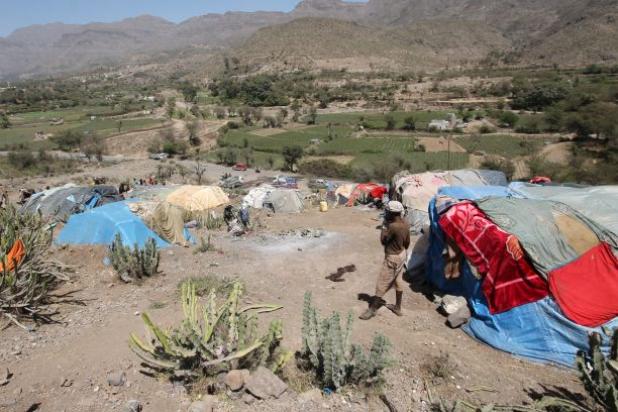
Yemen: Internal Displacement In Yemen Increases Six-fold In One Year
Thu, 28/04/2016 - 18:00
Marjolein Roelandt
One year into the conflict in Yemen, life for the people of Yemen has been characterised by uncertainty, forced displacement and a need for protection and humanitarian assistance. Living conditions in Yemen were already hard with major underdevelopment, financial crisis, poverty and gender inequality but, over the past year, the escalation in airstrikes, clashes on the ground and a de facto blockade on food, fuel and medicine imports have had a devastating impact on the population. The UN estimates that 82% of the population, or 21.2 million people, are in need of protection or humanitarian assistance.
More than 2.7 million people remain internally displaced. They fled violence, leaving behind their homes, belongings, economic opportunities and community support systems. IDPs have depleted their assets and incurred mounting debt, while living in cramped, difficult conditions, often with limited access to services and uncertainty about how long they can stay where they are. While 1 million IDPs are residing with host families or are otherwise supported by host communities, the collective capacity to cope is quickly eroding as family and friends struggle to support larger households. In some areas of Yemen, particularly where conflict has been ongoing and intense (such as Taizz, Al Jawf, or Marib), households have faced multiple displacements and have had to keep on finding new shelter alternatives.
There are many Shelter and Protection needs for IDPs, host communities and returnees. The three last Task Force on Population Movement reports have highlighted that shelter is the number one priority need of the IDPs. With NFIs (Blankets and clothes), 57% of
the priority needs are shelter related (source – TFPM 7th report).
Collective centers
Collective centres, usually public or abandoned buildings housing people who have fled their homes, exist in large numbers but lack the basic amenities, primary health care and other services and support that would be the minimum humanitarian standard in any formal camp environment provided by humanitarian actors. Collective centres usually lack appropriate management. IDPs living in them often cite amongst the biggest challenges feeling unsafe; lack of privacy; limited representation of their needs; limited freedom of movement and harassment from other IDPs or the host community.
Spontaneous settlements: A last resort for displaced families
IDP households living in spontaneous settlements – often very basic forms of informal camps – are finding that emergency shelters are not durable enough to withstand longer periods of displacement, multiple displacements, and climatic conditions. Spontaneous settlements usually represent a last resort for IDPs. IDPs have limited access to clean water and appropriate sanitation; the location can present safety concerns; and location of the settlements can cause land disputes. Displaced families have reported that they often face harassment from the local
communities with whom they share already scarce resources, including often limited water supply.
IDPs Hosted & Renting accommodation: Unsustainable for longer-term displacement
IDPs living with host families or in rented accommodation have increasingly fewer opportunities to earn income having left agricultural work and livestock behind. Inability to pay rent often leads to selling assets, increased debt; the risk of exploitation or the threat of eviction with limited alternative shelter options. In addition, disagreements with landlords about utility bills, overcrowding in the accommodation or tension with the host community are also issues faced by IDPs. A number of the same issues apply to the host communities, many of whom have sheltered IDPs for 6 to 8 months.
Response & Coordination
The Shelter / CCCM Cluster has identified a range of responses to meet the specific needs of IDPs according to their type of shelter:
- Robust emergency shelters are required for spontaneous shelters along with non-food items such as blanket, mattresses and kitchen sets to replace what has been left behind.
- Collective centres require upgrades to provide suitable shelter along with installation of WASH facilities.
- Household level assessments are required to assess the needs of IDPs living in rented accommodation or with
relatives/friends. It is likely that cash inputs will be required or assistance in upgrading individual houses and
shelters.
- The cluster is also looking to support returnees with non-food items, cash grants/livelihood support and
assistance with light repairs, if houses have been damaged.
Text: CCCM/Shelter/NFI Cluster Yemen
